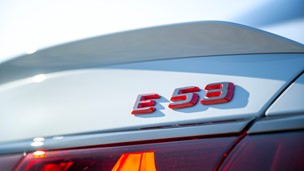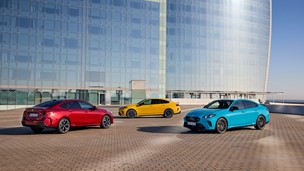The 500C is the open-top version of the 500 hatchback, offering wind-in-your-hair motoring for an extra £3,000. Like the DS3 Cabriolet (but unlike the MINI Convertible, another obvious rival) its side profile is maintained no matter what you do with the roof, which opens and closes along rails and can be made to do so at speeds of up to 37mph.
There are five trim levels - eccentrically named Pop, Colour Therapy, Lounge, S and Cult - and four engines. Two of these are examples of the 875cc two-cylinder turbo petrol TwinAir with power outputs of 84bhp and 104bhp. There's also a 68bhp 1.2-litre four-cylinder non-turbo petrol and a 94bhp 1.3 MultiJet diesel. Dualogic semi-automated manual transmission is available as a £750 alternative to the standard manual gearbox in 1.2-litre and 84bhp TwinAir models.
Performance
There's no difference in weight between the 500 hatchback and the 500C, so straightline performance is about the same in each case, which is to say that there isn't very much of it. The 1.2 engine gives the 500C a 0-62mph time of 12.9 seconds and a top speed of 99mph, while the fastest model, the 104bhp TwinAir, has equivalent figures of 10.0 seconds and 112mph. Dualogic and manual models perform almost identically.
It should be clear from the above that the 500C is not quick, and in fairness a lot of its potential customers won't be at all concerned about this, since it's more about style than performance. If you want something that looks like a 500C but goes a lot faster, the Abarth variant is the car for you.
Our favourite engine is the 0.9-litre TwinAir. For such a small unit, with only two cylinders, it pulls well from low revs, while emitting a characterful throaty rasp.
Ride and Handling
The 500C is easy and quite good fun to drive, with light steering, and there isn't enough power to get you into trouble unless you're being particularly careless.
The 500 hatchback is some distance from being dynamically the best supermini you can buy, and the 500C behaves in a very similar manner. Neither is bad, though, and even if they were the looks (along with the roofless appeal of the 500C) would go a long way to overcoming any objections. The 500C is easy and quite good fun to drive, with light steering, and there isn't enough power to get you into trouble unless you're being particularly careless. Reversing can be difficult, not because of any chassis fault but because it's so hard to see what's behind you. TwinAirs are the nicest to drive because they have the least weight over the front axle. The lack of a solid roof means that there's some body shake, but no more than you'll find in the conceptually similar DS3 Cabrio.
Interior and Equipment
Fiat put the 500C on sale in Britain before it did so in any other country, including even its home market of Italy.
The roof has three positions: closed, open above the heads of all the passengers and fully folded above the boot (but not actually in it, which would make the already poor 182-litre luggage capacity even worse). In the last of these visibility is so bad that if you want to see what's directly behind the car you have to stand up and look round. The high-level brake light is visible no matter where the roof is. The interior, though cramped in the back, is very nicely styled in a faux-1950s sort of way. This works well in the hatchback and it works well here too. All versions have air-conditioning, electrically adjustable door mirrors, start/stop, tyre pressure monitoring, a space-saver spare wheel and seven airbags. The Pop and the Colour Therapy (which is really just a Pop with special paint and a few other styling changes) have steel wheels with plastic covers. Alloy wheels come on to the scene with the Lounge, as do automatic climate control, rear parking sensors, foglights and Bluetooth connectivity. The S comes with privacy glass, a seven-inch TFT digital instrument display, sports seats, side skirts and a chrome exhaust tailpipes, while the Cult is the same as an S but has leather rather than cloth upholstery. DAB digital radio is not available on any model.
Cost
Ten of the fifteen variants - in other words all the ones with the TwinAir or diesel engines - have official CO2 emissions below 100g/km (92g/km in the case of the 84bhp TwinAir) which means you don't have to pay Vehicle Excise Duty on them.
The £3,000 premium over the hatchback, which represents nearly a 30% increase in the case of the 1.2-litre Pop, may be off-putting and should certainly inspire some careful thought about whether you really want a convertible 500 at all. Running costs should, however, be modest. Ten of the fifteen variants - in other words all the ones with the TwinAir or diesel engines - have official CO2 emissions below 100g/km (92g/km in the case of the 84bhp TwinAir) which means you don't have to pay Vehicle Excise Duty on them. As well as being the second quickest model, the diesel is also, on paper and probably in real life, the most economical, recording a combined figure of no less than 78.5mpg on the EU test. The TwinAirs are rated at around 70mpg (the exact figure depending on power output and gearbox) but in Fiats and Alfa Romeos fitted with these engines it's difficult to get anywhere near the official figure, partly because they sound as if they're about to stall when they're actually not and there's a temptation to change down a gear unnecessarily.
Our Verdict
Study any area of the 500C in detail and you'll find things to criticise. This, however, is a car which is more than the sum of its parts. Its appearance is thoroughly charming, and TwinAir versions sound good and offer decent performance. The extra price compared with the 500 hatchback is slightly alarming, but for those who love the car that won't matter a bit.




